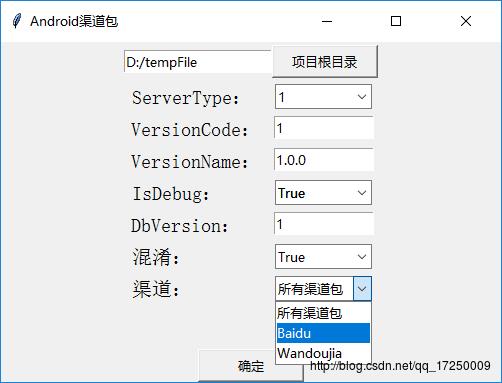Android QA专用,Python实现不一样的多渠道打包工具
Posted 一口仨馍
tags:
篇首语:本文由小常识网(cha138.com)小编为大家整理,主要介绍了Android QA专用,Python实现不一样的多渠道打包工具相关的知识,希望对你有一定的参考价值。
相对于美团打包方案,我为什么要写这个工具?
除了Gradle的多渠道打包,目前最流行的应该是美团(美团Android自动化之旅—生成渠道包、美团Android自动化之旅—适配渠道包、Walle)使用Python直接添加渠道文件的打包方式了,速度真是杠杠的!但是,这里有一个问题:需要一个已签名无渠道号的APK,那么问题来了,这个APK哪里来的?懂行的朋友该说了,Gradle随便打个Release包不完事了嘛。是的,我也是这么想的。但是领导说QA打包的时候需要改一部分配置文件代码(例如APP版本、后台环境、数据库版本bulabulabula),这样会带来潜在的问题。能不能直接通过命令行的形式打包,即QA不需要改动任何代码,只需要设置不同的参数就好了。小脑瓜一转,有了。Gradle可以。吭哧吭哧半天,做好了。然后QA说:敲命令行多麻烦,还可能出错。能不能直接写个界面,我点点按钮就可以了。So,就有了这个Python写的工具。我们暂时叫它QA打包工具。
写在前面
为什么要有这个QA打包工具,这个工具存在的唯一目的就是根据QA的选择,执行命令行打包,实际还是Gradle打包。如果和您预期不同或者您已经一眼看穿这小把戏。左拐出门,走好了您馁。如果您对Gradle配置参数打包或者对Python如何实现感兴趣,请继续~
效果图

First blood 多渠道配置
第一滴血总让人满怀期待,完后只剩空虚寂寞冷。千篇一律的东西。这里以百度和豌豆荚为例,直接贴代码。
android
productFlavors
wandoujia
baidu
productFlavors.all flavor ->
flavor.manifestPlaceholders = [UMENG_CHANNEL_VALUE: name]
// 重命名生成的apk文件
applicationVariants.all variant ->
variant.outputs.each output ->
def outputFile = output.outputFile
if (outputFile != null && outputFile.name.endsWith('.apk') && variant.productFlavors.size() > 0)
File outputDirectory = new File(outputFile.parent);
def fileName = "(" + variant.productFlavors[0].name + ")Test_$defaultConfig.versionName_$releaseTime().apk"
output.outputFile = new File(outputDirectory, fileName)
def releaseTime()
return new Date().format("yyyyMMddHHmmss", TimeZone.getTimeZone("UTC"))
Gradle设置参数后的打包命令
打所有渠道包
gradlew assembleRelease -PSERVER_TYPE=1 -PIS_DEBUG=false -PMINIFYENABLED=false打指定渠道包(以百度为例)
gradlew assembleBaiduRelease -PSERVER_TYPE=1 -PIS_DEBUG=false -PMINIFYENABLED=falsegradlew assebleXXXX是默认的打包方式,-P后面是我们自己配置的各种参数。
Gradle参数配置
首先想一个问题,Gradle命令中的参数怎么就莫名其妙变成了我们程序可访问的参数。一个是Gradle一个是Android,真正实现了两不沾。破解也很简单,用文件连接。
Gradle在Build时,会在app/build/generated/source/buildconfig/渠道/release/包名/下生成BuildConfig.java文件,就是这个文件实现了两者的通信。
Gradle设置及获取参数(划重点)
代码是最好的语言表述者。
android
defaultConfig
applicationId "com.yikousamo.test"
versionCode 1
versionName "1.0.0"
minSdkVersion 14
targetSdkVersion 21
// 服务器类型
buildConfigField 'int', 'SERVER_TYPE', '1'
// 是否开启调试,默认开启
buildConfigField 'boolean', 'IS_DEBUG', 'true'
// 是否开启混淆,默认不混淆
buildConfigField 'boolean', 'MINIFYENABLED', 'false'
buildTypes
if (project.hasProperty('SERVER_TYPE')
&& project.hasProperty('IS_DEBUG')
&& project.hasProperty('MINIFYENABLED'))
release
buildConfigField 'int', 'SERVER_TYPE', SERVER_TYPE
buildConfigField 'boolean', 'IS_DEBUG', IS_DEBUG
buildConfigField 'boolean', 'MINIFYENABLED', MINIFYENABLED
minifyEnabled Boolean.parseBoolean(MINIFYENABLED)
zipAlignEnabled false
shrinkResources false
signingConfig signingConfigs.gliv
proguardFiles getDefaultProguardFile('proguard-android.txt'), 'proguard-rules.pro'
debug
minifyEnabled false
zipAlignEnabled false
shrinkResources false
// 包名增加后缀,不同apk可以在相同设备上安装
applicationIdSuffix ".debug"
signingConfig signingConfigs.gliv
proguardFiles getDefaultProguardFile('proguard-android.txt'), 'proguard-rules.pro'
这里配置了三个可以参数,分别是SERVER_TYPE,IS_DEBUG,MINIFYENABLED,defaultConfig里是对应的默认值。可以依据自己实际需求增加更多的参数。道理一样,不再赘述。
判断有没有指定参数的方法为project.hasProperty('XXX'),下面就是设置到对应的参数中。这里有个小技巧,debug设置applicationIdSuffix相当于改包名,这样在同一部手机上可以同时存在debug和release包。具体可以看下我另一篇文章Android package属性、package name和Application ID三者的联系及区别。
设置完参数之后,在Build时,在BuildConfig中会生成对应的代码。
package com.yikousamo.test;
public final class BuildConfig
public static final boolean DEBUG = false;
public static final String APPLICATION_ID = "com.yikousamo.test";
public static final String BUILD_TYPE = "release";
public static final String FLAVOR = "baidu";
public static final int VERSION_CODE = 1;
public static final String VERSION_NAME = "1.0.0";
// Fields from build type: release
public static final int DB_VERSION = 1;
public static final boolean IS_DEBUG = true;
public static final boolean MINIFYENABLED = false;
public static final int SERVER_TYPE = 1;
// Fields from default config.
注意下这里的包名是APP的包名。这也就意味着我们可以在代码中引用这个类。例如,在BaseApplication中设置引用public static boolean isDebug = BuildConfig.IS_DEBUG。其余依据业务需要,同理。到这里就已经完全完成了多渠道打包各种参数的配置。接下来是Python实现命令行打包。
Python打包工具实现思路
前文说过,Python(3.5.0版本)在这里唯一的作用是用界面替代QA输入命令行。
Python执行命令行的方式有三种:
os.system("cmd")subprocess.Popencommands.getstatusoutput
作为Python新手,三种方式的优劣我就不妄加评价了。凑合着用,反正在我眼里都是垃圾。这里采用第二种产生子进程的方式执行cmd命令。界面实现采用的tKinter。代码很简单,也没有多少行。直接放大了。
#!/usr/bin/env python3
# -*- coding: utf-8 -*-
# 一口仨馍
import subprocess
from tkinter import *
from tkinter import messagebox
from tkinter.ttk import Combobox
from tkinter.filedialog import askdirectory
import os
root = Tk()
root.title("Android渠道包")
root.geometry('500x340') # 是x 不是*
rootPath = StringVar() # 项目根目录
frm = Frame(root)
#第一个字母直接大写,省去upperCase
channels = ['Baidu', 'Wandoujia']
UN_SPECIAL_CHANNEL = '所有渠道包'
def get_frame():
frame = Frame(frm, pady=3)
frame.pack()
return frame
def get_entry(frm):
entry = Entry(frm, width=12)
entry.pack()
return entry
def get_combobox(frm, value):
combobox = Combobox(frm, width=9)
combobox["state"] = "readonly" # 只读
combobox['values'] = value # 设置下拉列表的值
combobox.current(0) # 设置下拉列表默认显示的值,0为 numberChosen['values'] 的下标值
combobox.pack()
return combobox
def get_label(frm, text):
Label(frm, text=text, font=(17), width=14,anchor ='w', justify='left').pack(side=LEFT)
def select_path():
path_ = askdirectory()
rootPath.set(path_)
# 选择根目录
frm_choose_root_dir = get_frame()
rootPathEntry = Entry(frm_choose_root_dir, textvariable=rootPath, width=18)
rootPathEntry.pack(side=LEFT)
Button(frm_choose_root_dir, text="项目根目录", width=12, command=select_path).pack()
frm_choose_root_dir.pack(side=TOP)
# ServerType
frm_server_type = get_frame()
get_label(frm_server_type, 'ServerType:')
ServerTypeCombox = get_combobox(frm_server_type, (0, 1, 2, 3))
# VersionCode
frm_version_code = get_frame()
get_label(frm_version_code, 'VersionCode:')
VersionCodeEntry = get_entry(frm_version_code)
# VersionName
frm_version_name = get_frame()
get_label(frm_version_name, 'VersionName:')
VersionNameEntry = get_entry(frm_version_name)
# IsDebug
frm_is_debug = get_frame()
get_label(frm_is_debug, 'IsDebug:')
IsDebugComboBox = get_combobox(frm_is_debug, (True, False))
# DbVersion
frm_db_version = get_frame()
get_label(frm_db_version, 'DbVersion:')
DbVersionEntry = get_entry(frm_db_version)
# 混淆
frm_minifyenabled = get_frame()
get_label(frm_minifyenabled, '混淆:')
minifyenabledComboBox = get_combobox(frm_minifyenabled, (True, False))
# 指定渠道
frm_special_release = get_frame()
get_label(frm_special_release, '渠道:')
channels.insert(0, UN_SPECIAL_CHANNEL)
SpecifyReleaseComboBox = get_combobox(frm_special_release, tuple(channels))
def click_confirm():
if(rootPathEntry.get().strip() == "" or
VersionCodeEntry.get().strip() == "" or
VersionNameEntry.get().strip() == "" or
DbVersionEntry.get().strip() == ""):
messagebox.askokcancel('提示', '干哈~不填完咋么打包~')
return
do_gradle()
def do_gradle():
# 切换到项目根目录
os.chdir(rootPathEntry.get())
# 获取当前工作目录
print(os.getcwd())
if SpecifyReleaseComboBox.get() == UN_SPECIAL_CHANNEL:
do_all_release()
else:
do_specify_release(SpecifyReleaseComboBox.get())
# 打指定渠道包
def do_specify_release(channel):
cmd = 'gradlew assemble'+channel+'Release' \\
' -PSERVER_TYPE=' + ServerTypeCombox.get() + \\
' -PVERSION_CODE=' + VersionCodeEntry.get() + \\
' -PVERSION_NAME=' + VersionNameEntry.get() + \\
' -PDB_VERSION=' + DbVersionEntry.get() + \\
' -PIS_DEBUG=' + IsDebugComboBox.get().lower() + \\
' -PMINIFYENABLED=' + minifyenabledComboBox.get().lower()
subprocess.Popen(cmd, shell=True, stdout=subprocess.PIPE)
# 打所有的渠道包
def do_all_release():
cmd = 'gradlew assembleRelease' \\
' -PSERVER_TYPE=' + ServerTypeCombox.get() + \\
' -PVERSION_CODE=' + VersionCodeEntry.get() + \\
' -PVERSION_NAME=' + VersionNameEntry.get() + \\
' -PDB_VERSION=' + DbVersionEntry.get() + \\
' -PIS_DEBUG=' + IsDebugComboBox.get().lower() + \\
' -PMINIFYENABLED=' + minifyenabledComboBox.get().lower()
subprocess.Popen(cmd, shell=True, stdout=subprocess.PIPE)
Button(root, text='确定', width=12, command=lambda: click_confirm()).pack(side=BOTTOM)
frm.pack()
root.mainloop()多渠道验证
假设现在已经打了一个豌豆荚的包。那么怎么验证是否真的改变了Anroidmanifest.xml中UMENG_CHANNEL对应的值呢?也许你需要ApkTool。
ApkTool可以反编译得到程序的源代码、图片、XML配置、语言资源等文件。这里我们只关心Anroidmanifest.xml。
反编译步骤:
- 下载ApkTool
- 将需要反编译的APK文件放到该目录下,打开命令行界面 ,定位到apktool文件夹
- 输入命令:java -jar apktool_2.2.1.jar decode test.apk
- 之后发现在文件夹下多了个test文件夹,查看
Anroidmanifest.xml即可
以上是关于Android QA专用,Python实现不一样的多渠道打包工具的主要内容,如果未能解决你的问题,请参考以下文章